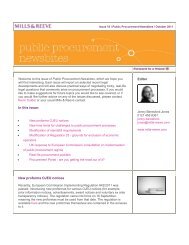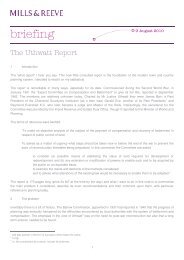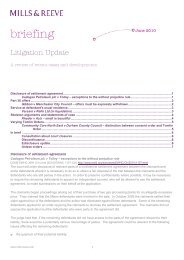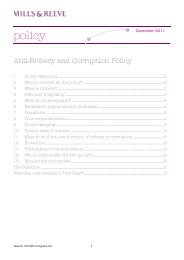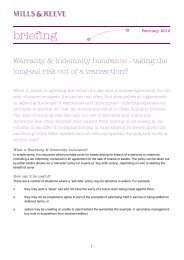Public Eye - Spring 2008 - Mills & Reeve
Public Eye - Spring 2008 - Mills & Reeve
Public Eye - Spring 2008 - Mills & Reeve
Create successful ePaper yourself
Turn your PDF publications into a flip-book with our unique Google optimized e-Paper software.
Equal pay: recent<br />
developments in<br />
the public sector<br />
Charles Pigott 01223 222411<br />
charles.pigott@mills-reeve.com<br />
Overview<br />
Over the past year we have begun to see<br />
cases emerging that reflect the enormous<br />
complexity of the equal pay issues<br />
generated by Agenda for Change in the<br />
NHS and the Single Status Agreement in<br />
the local authority sector. The cases we<br />
refer to below have been brought in the<br />
local authority sector in the North East, but<br />
the legal principles can readily be translated<br />
to the public sector as a whole.<br />
Pay protection<br />
Pay protection (or “red circling”) is often<br />
used by employers to protect certain<br />
groups of workers from the immediate<br />
reduction in pay they would otherwise<br />
have faced as a result of the<br />
implementation of a job evaluation scheme<br />
(JES). Given that this can result in workers<br />
in traditionally female jobs (like catering or<br />
cleaning) continuing to receive less pay<br />
than their male comparators during the pay<br />
protection period, is this in itself a breach<br />
of the Equal Pay Act?<br />
The Employment Appeal Tribunal (EAT) has<br />
come to two different decisions on this<br />
point, in cases which had very similar facts.<br />
Both cases involved a group of female<br />
workers in the North East who were able<br />
to establish equal pay claims up to the<br />
point the council’s JES had been<br />
implemented. However, because of pay<br />
protection, they continued to be worse off<br />
than their male comparators even after the<br />
implementation date. They argued that<br />
they should also receive the same level<br />
of “pay protection” as their male<br />
counterparts.<br />
In the first decision (Bainbridge (No 1) v<br />
Cleveland Borough Council) the EAT ruled<br />
that the council’s pay protection scheme<br />
could not be justified, and therefore the<br />
claimants’ pay should be raised to the level<br />
of the protected pay of their male<br />
comparators. In the second decision,<br />
announced eight months later<br />
(Middlesbrough Council v Surtees), the EAT<br />
reached the opposite conclusion. The only<br />
difference between the two cases was that<br />
in Bainbridge the council had already<br />
conceded some of the equal pay claims,<br />
whereas in Surtees this had not happened.<br />
Both appeals have now been heard by the<br />
Court of Appeal, but at the time of writing<br />
it has not announced its decision.<br />
Does a JES have retrospective effect?<br />
Ms Bainbridge and her cohort of litigants<br />
have not been idle. Not content with their<br />
victory in their first outing, they went to<br />
the EAT a second time. This time the issue<br />
was whether the job evaluation scheme<br />
introduced by Cleveland Council in April<br />
2004 had retrospective effect. In other<br />
words, did the fact that the JES had rated<br />
their work as equivalent to that done by<br />
their male comparators with effect from<br />
April 2004 entitle them to back-date their<br />
equal pay claims to earlier periods when<br />
both they and their comparators were<br />
doing comparable jobs?<br />
In a decision announced earlier this<br />
year the EAT ruled that a JES was not<br />
retrospective in this sense. While the<br />
claimants may well have had valid equal<br />
pay claims for earlier periods, the JES was<br />
not an automatic passport to success. They<br />
would have to prove their claims – which<br />
would have to be for like work or work of<br />
equal value – in the usual way.<br />
Back pay<br />
While the second Bainbridge decision is<br />
obviously helpful to employers introducing<br />
a JES, it does not necessarily mean that<br />
employees will not be able to bring<br />
back-dated claims in respect of the period<br />
prior to its implementation. The difficulties<br />
that public sector employers currently face<br />
in relation to back pay is graphically<br />
illustrated by the EAT’s recent decision<br />
involving the GMB.<br />
GMB v Allen involves a number of women<br />
employed by Middlesbrough Council who<br />
considered that they had been let down<br />
by the way the GMB had negotiated their<br />
claims for back pay under the Equal Pay<br />
Act. Their argument was that the union<br />
had pushed for pay protection for the<br />
members who stood to lose pay as a result<br />
of the council’s JES (who were<br />
predominantly male) at the expense of<br />
the claims for back pay brought by their<br />
6



